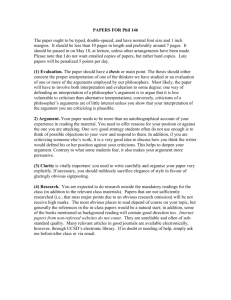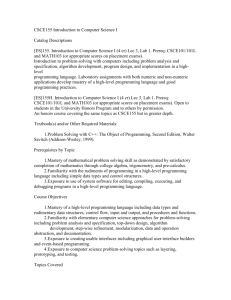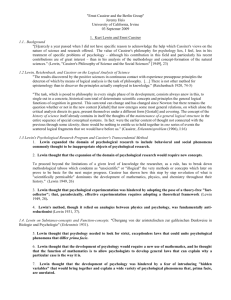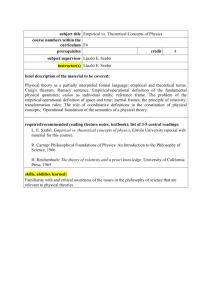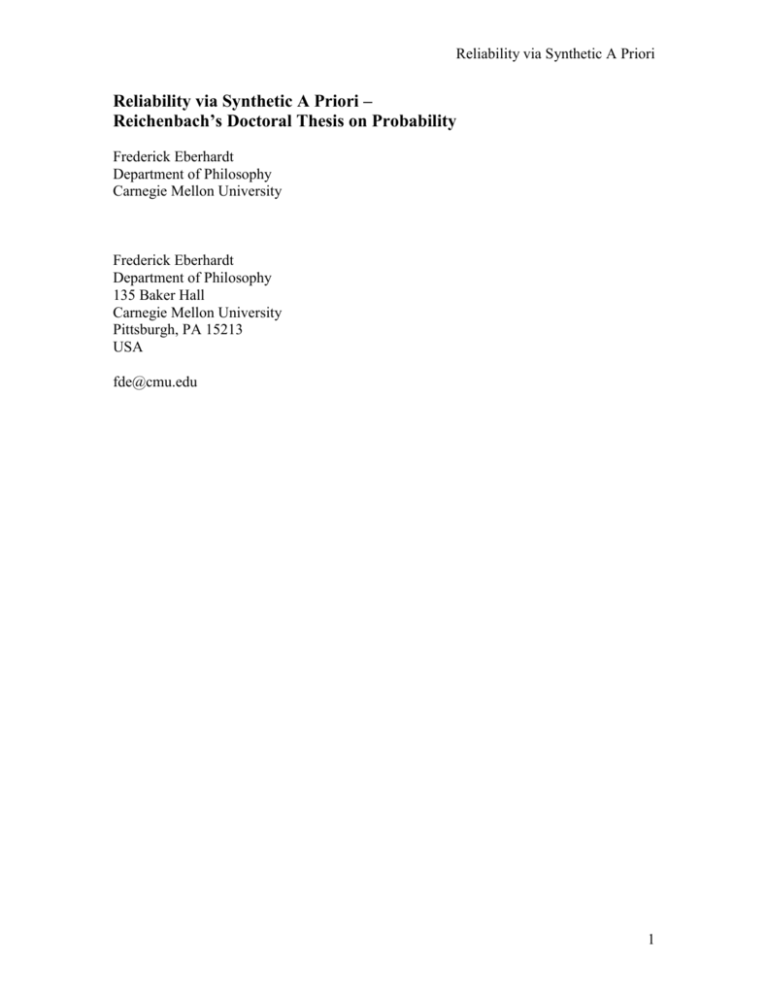
Reliability via Synthetic A Priori
Reliability via Synthetic A Priori –
Reichenbach’s Doctoral Thesis on Probability
Frederick Eberhardt
Department of Philosophy
Carnegie Mellon University
Frederick Eberhardt
Department of Philosophy
135 Baker Hall
Carnegie Mellon University
Pittsburgh, PA 15213
USA
fde@cmu.edu
1
Reliability via Synthetic A Priori
Abstract:
Reichenbach is well known for his limiting frequency view of probability, with his most
thorough account given in The Theory of Probability in 1935/49. Perhaps less known are
Reichenbach's early views on probability and its epistemology. In his doctoral thesis
from 1915, Reichenbach espouses a Kantian view of probability, where the convergence
limit of an empirical frequency distribution is guaranteed to exist thanks to the synthetic
a priori principle of lawful distribution. Reichenbach claims to have given a purely
objective account of probability, while integrating the concept into a more general
philosophical and epistemological framework. I will give a brief synopsis of his thesis
and an analysis of his argument. Many of Reichenbach’s major developments in
probability already surface – albeit in sometimes quite different form – in this early piece
of work.
1. Historical Background
Reichenbach wrote his thesis Der Begriff der Wahrscheinlichkeit für die mathematische
Darstellung der Wirklichkeit largely independently in 1914. It was accepted in March
1915 by Paul Hensel and Max Noether at the University of Erlangen. Unlike his later
views, Reichenbach's thesis was deeply influenced by the Kantian view dominant in
philosophy and epistemology at the time. Reichenbach had studied with Ernst Cassirer,
Max Planck and David Hilbert, among others, in Berlin, Stuttgart, Munich and Göttingen.
At the time Reichenbach was writing his thesis (1914) the mathematics of probability
was quite developed but there was not yet an agreed upon axiomatization of probability,
although ideas were around (e.g. Bohlmann, 1901). Kolmogorov published his axioms in
1933, while Reichenbach published his own very similar axiomatization in a paper in
1932. The whole discussion surrounding the notion of randomness (von Mises, Church,
Ville, Copeland etc.) had not yet started.
2. Thesis Synopsis
Reichenbach's thesis sets out to give a detailed account of the concept of probability as it
is used in the sciences and aims to tie this concept into the broader philosophical and
epistemological context. Reichenbach intends to provide a purely objective account of the
meaning of probability, a foundation for a rational expectation and conditions for the
knowability of a probability claim.
Reichenbach sets his thesis against the background of the work of Johannes von Kries
(1886) on the one hand and Carl Stumpf (1892) on the other. Kries’ view of probability is
based on equi-probable events. The equi-probability of events is defined by a basic set of
2
Reliability via Synthetic A Priori
“ur-events”, which are all equally likely. These ur-events can be found by tracing back
the (causal) history of events until no further reason can be found to make one event more
likely than another. At this point the principle of insufficient reason can be applied to
conclude that these events are equi-probable. That is, the principle of insufficient reason
supports the inference from events for which there is no reason to believe one is more
likely than the other, to the claim that these events are equi-probable. Based on the equiprobability of these ur-events, probabilities for composite events can be determined. It
remains unclear what happens if there are conflicting states to determine ur-events (as in
e.g. Bertrand’s paradox). In modern terminology Kries could be described as an objective
Bayesian. He believes that probability is objective and that there is in some sense one
correct objective probability for any event, but that ultimately, a human component enters
into the determination of the reference for equi-probable events.
Reichenbach takes issue with the principle of insufficient reason since he views it as a
subjective element in the determination of probabilities that is alien to the scientific use
of probability. Consequently, Reichenbach saw his task as developing Kries' account of
probability in such a way that there is no need for the principle of insufficient reason to
determine equi-probability and that instead probability claims can be couched in a purely
objective framework.
Both Kries' and Reichenbach's views contrast with that of Carl Stumpf. Stumpf has a
purely subjectivist view of probability. He takes probability to represent degrees of belief.
He does not present his view explicitly in terms of wagers, but it could be framed in those
terms. Stumpf takes the realization that a die is biased to constitute a change in
probability as opposed to a correction. He does not view the prior belief that all sides
have equal probability as false. Instead, probability only constitutes a summary of the
current knowledge an individual has about the events under consideration – and that can
be updated. In that sense, knowledge of the equal probability of events is to Stumpf the
same as equal lack of knowledge about the probability of events.
In order to remove the need for the principle of insufficient reason Reichenbach uses an
argument based on arbitrary functions borrowed from Henri Poincaré (1912). In modern
terms one would refer to this argument as an analysis of strike ratios.1 The event space is
divided into narrow equally wide alternating black and white stripes (or squares, if 2dimensional). Outcomes of trials that fall within each square are counted and plotted as a
histogram. As the number of outcomes increases, the histogram approximates a Riemann
integrable function, as shown in Figure 1 below.
3
Reliability via Synthetic A Priori
Figure 1: Strike ratio: If the black
and white stripes are equally
wide, the probability of a white
outcome is the same as the
probability of a black outcome.
Furthermore, the number of hits on white stripes is approximately equal to the number of
hits on black stripes. That is, we find, no matter what the Riemann integrable function is,
the ratio of hits on white to hits on black stripes is approximately equal. Reichenbach
thereby shows that it is not the equi-probability of the ur-events that is required to make
sense of probability claims, but rather the existence of the convergence limit of the
empirical frequency distribution to a continuous function. In particular, if the black
stripes were twice as wide as the white ones, we would have a strike ratio of 2:1, i.e. not
equal, but we could still speak of a probability distribution, as long as the empirical
distribution converges to a continuous function. With the argument based on strike ratios
Reichenbach replaces the principle of insufficient reason with an assumption about the
existence of a convergence limit.2
Consequently, his next task is to determine which conditions are necessary in order to
ensure the existence of a convergence limit of the empirical distribution. Reichenbach
identifies causally independent and causally identical trials as two such conditions. He
then attempts to show that causally independent and causally identical trials imply
probabilistically independent and identically distributed trials. This would – although
Reichenbach never explicitly states it that way – provide a foundation for the weak law of
large numbers, i.e. convergence in probability. Reichenbach does not provide a proof of
the inference, but he does hint at an argument based on the invariance of distribution
under intervention. He claims that the marginal distribution of one variable is invariant
under intervention on a causally unconnected variable.3 In order to complete the proof,
Reichenbach would need something similar to the causal Markov assumption, first
mentioned by Kiiveri and Speed (1982) that would connect the causal structure to the
probability distribution. In his thesis, he only appeals to the intuition provided by his
argument.
Even though causally independent and identically distributed trials would give
Reichenbach the conditions for the application of the weak law of large numbers, he does
not refer to it here or discuss its relevance. One interpretation is that the weak law of
large numbers only guarantees convergence in probability. Since probability is something
he wants to define, convergence in probability would imply a circular foundation.
4
Reliability via Synthetic A Priori
Instead, Reichenbach attempts to make a claim that guarantees convergence with
certainty.
In retrospect it might be obvious that search for a certain convergence guarantee is a nonstarter. Later in his career, Reichenbach takes several different approaches to address this
problem. He develops ideas of higher-order probabilities that guarantee convergence (in
higher-order probability) and argues for what comes to be known as the straight rule,
where belief in the convergence is taken to be the best bet we have in finding the truth,
even if no guarantee of convergence is provided.
In his thesis, however, Reichenbach takes an entirely different approach. Reichenbach
argues that the assumption of a convergence limit of the empirical frequency distribution
is guaranteed by a synthetic a priori principle: the principle of lawful distribution. The
argument for the synthetic a priori status of this principle is, in short, as follows. It is a
transcendental argument in the spirit of Kant's argument for the synthetic a priori
principle of causality.4
Reichenbach claims that our scientific knowledge is represented in the laws of nature.
These laws, or at least some of them, are causal laws. In his view at the time, causal
relations were assumed to be relations between individual token events, not between
types of events – entirely in line with Kant's view of causality (or at least one of its
interpretations). Hence, if our causal knowledge is restricted to token events, then in
order to attain knowledge in terms of causal laws, one needs some aggregating
mechanism that aggregates token causal events into scientific laws. This aggregation
procedure is provided by the laws of probability.5 We only ever have finitely many token
causal events to aggregate. If we had no guarantee that the empirical frequency
distribution of these finitely many token causal events converges, then we could not have
the knowledge represented in the laws of nature. But we do have this knowledge, and
hence we must have a guarantee of convergence. Hence, the principle of lawful
distribution is a necessary ingredient for the attainment of knowledge; it is a synthetic a
priori principle that complements Kant's principle of causality.
Reichenbach thus provides an entirely objective account of probability. It is not circular,
since it is based on causal independence and causally identical trials. It does not rely on
the principle of insufficient reason, since that is replaced by an analysis of strike ratios
and the assumption of a convergence limit of the empirical frequency distribution. The
limit is guaranteed by the synthetic a priori principle of lawful distribution, for which he
provides a transcendental deduction. Furthermore, he claims this account provides the
foundation for a rational expectation. Reichenbach argues that a rational expectation may
be based on an inference that takes the empirical frequency distribution to be the true
probability distribution: It is true that the empirical distribution may diverge again before
it converges, but the guaranteed existence of some (unknown) finite point at which
convergence occurs is sufficient to support such an expectation.6
Reichenbach claims that if convergence does not occur, then one has an indication that
the conditions (causal independence of trials, causally identical trials) have not been
5
Reliability via Synthetic A Priori
satisfied. However, such lack of convergence does not refute the principle of lawful
distribution. He admits that his argument implies that the principle of lawful distribution
is untestable, but he points out that the same criticism applies to Kant, whose principle of
causality also fails to be testable – that is the nature of synthetic a priori principles.7
3. Analysis of Thesis
The story may not be quite as rosy. Reichenbach does successfully dismiss accounts of
equi-probability based on symmetry considerations, and thereby avoids the obvious
paradoxes of the choice of the geometrical reference classes for the assignment of equal
probabilities (e.g. Bertrand's paradox). And it is true that Reichenbach addresses the
subjective element due to the principle of insufficient reason in Kries' account and
replaces it with a different assumption. While the end product might now seem like a
more objective theoretical account for the foundations of probability, it seems like one
cannot dispense with the principle of insufficient reason entirely. Reichenbach does not
provide any guidance on how trials, that form the basis of his account of probability, are
supposed to be judged (i) causally independent, and (ii) causally identical. It seems that
while the principle of insufficient reason may no longer be needed to judge the equiprobability of events, it seems essential to determining causal independence.
But even if this could be accounted for, Reichenbach provides no proof of how causal
independence and causally identical trials imply probabilistically independent and
identically distributed trials. For the step from identical causes to an identical distribution
Reichenbach only provides the claim that repeated trials must be of the “same” process.
Two processes are the same if they differ only in their position in space and time and all
physically measurable variables have the same value. There are two interpretations of this
statement. The first is that causes just amount to probabilistic features in the population
and hence trials with identical causes just are those with identical distributions. This
would not be an interpretation in the spirit of the thesis, since causal relations are taken to
be token relations and therefore related to but distinct from probabilistic relations.
Furthermore, this would imply that his account of probability is circular (or tautological)
since we would have an identity between trials with identical causes and identically
distributed trials. The second interpretation, which I suggested above, is that identical
distribution follows from identical causes. But in this case Reichenbach has provided no
proof.
For the step from causally independent trials to probabilistically independent trials a
similar analysis applies: If one knows one has causally independent trials, then
Reichenbach needs to show how causally independent trials lead to probabilistic
independence. Reichenbach does not provide the derivation, but he does indicate (without
proof) that causal independence goes together with an invariance of the marginal
distribution of one variable under interventions on other variables, which in turn allows
for the factorization of the joint probability. But the argument is opaque.
6
Reliability via Synthetic A Priori
There is a further concern that even if the steps in his argument were filled with proofs,
that the conditions he lays out are too strong: One might quite sensibly argue that a
sequence of trials can exhibit a certain probability of an event type, even if the trials are
not completely independent or entirely causally similar. For example, repeated flips of
the exact same coin might exhibit a probability of 1/2 of heads, even though the trials in
the sequence are not causally similar, since the coin measurably wears down.8 The point
is that it is doubtful whether there are many examples in real life that satisfy his
conditions. As an aside, in The Theory of Probability Reichenbach does generalize his
notion of independent trials to sequences of trials that are normal. The class of normal
sequences is more general than that of sequences of independent trials (or random
sequences), but excludes deterministic or patterned sequences.
With regard to this first aim of an objective account of probability, there is one more
serious epistemological concern: The way the argument is laid out, Reichenbach provides
a reduction of probabilistic relations to causal relations (plus a few assumptions). If the
principle of insufficient reason is not to play any role at the foundations, then causal
independence would have to be taken as a primitive. This would seem like a rather strong
assumption. The question that remains regarding the first aim of his thesis is whether
Reichenbach really gave an objective foundation for probability or whether he gave a
more detailed analysis of the principle of insufficient reason. The concern is that reducing
probability concepts to causal concepts seems to be defining something simple in terms
of something more complicated or at least equally undefined and epistemically
intractable.
Reichenbach's second aim was to give an account of rational expectation that provides a
normative account for the choice of an action based on the true probability of the
occurrence of events. In order to do so, he needed to provide a semantic analysis of
probability claims and explain how we could obtain any knowledge about such claims.
This goes hand in hand with the integration of his work into a general epistemological
framework.
The results of this second part of his investigation are unsatisfying. Reichenbach
unfortunately succumbs to the strong influence of the Kantian philosophy, which seems
to have prevented him from presenting interesting results. He essentially claims that we
must assume that the strike ratios of the process under consideration will converge, since
otherwise the knowledge represented in the laws of science would be impossible to attain.
Reichenbach refers to the weak law of large numbers, but does not lay out its relevance to
the problem he is trying to tackle, nor does he discuss why it would be inadequate.
Instead, he argues that a guarantee of convergence can be given with certainty. But the
claim is – even if one believes the transcendental deduction – extremely weak and
practically useless: Convergence is guaranteed at some point after some finite number of
trials, but the actual point is unknown. This claim makes no headway into the actual
question of how we are supposed to interpret the empirical distribution after a finite
number of trials, what it tells us about future events or future distributions and how we
could verify or falsify any probability claim. Furthermore, it seems like an extremely
weak support for the basis of a rational expectation: Use the empirical distribution as
7
Reliability via Synthetic A Priori
basis for inferences because at some point the empirical distribution converges to the true
distribution. No measure of confidence in the empirical distribution or measure of
distance between the empirical and true distribution is provided.
A synthetic a priori assurance that the empirical distribution of a finite number of trials
converges at some point begs the question of what assurance we have regarding
probability claims based on empirical facts. Reichenbach does not deny this and admits
that there is no way to disprove the principle of lawful distribution. But rather than
admitting that he has provided an unsatisfactory argument, he argues that Kant's
argument for the principle of causality was no better. Sadly, reference to a poor argument
of a greater authority does not make the present argument any better.
As a result, we are left with a technical account of a (well, let's say) objective foundation
of probability (strike ratios approximating a continuous function), but with no satisfactory
meaning to our probability claims, as the convergence guarantee is bogus. As a result we
have no adequate account of the conditions for the ascertability of probability claims.
I have not read Reichenbach as a limiting frequentist in 1915, since he does not explicitly
identify the probability with the limit of the relative frequency in an infinite series and he
points out in later work that he did not do so in his thesis.9 The role of the limit is taken
up by the synthetic a priori assurance given by the principle of lawful distribution. But
since Reichenbach does require some kind of convergence the synthetic a priori principle
seems very much like a limiting frequency wolf in the coat of some kind of sheep.
4. Epilogue
In unpublished autobiographical notes from August 6, 1927, Reichenbach gives a brief
review of the main results of his thesis. He lists the following10:
(i)
(ii)
(iii)
(iv)
The assumption of equi-probable events can be replaced by a continuity
assumption.
The continuity assumption is essential to an understanding of causal claims.
An attempt to provide a guarantee of certain convergence.
An attempt to show that the principle of lawful distribution is a synthetic a
priori principle and necessary for all knowledge.
In 1927 Reichenbach views points (iii) and (iv) as failures. His work in The Theory of
Relativity and a priori Knowledge (1920/1965), resulting from the lectures Reichenbach
attended with Einstein after his doctoral thesis, convinced him of the impossibility of
synthetic a priori principles. On (iii) he concedes that one can only guarantee
convergence in probability (as is the case with the weak law of large numbers), rather
than convergence with certainty. However, he considers the link between probability and
causality (ii) to be one of the most important discoveries since Hume.
The results of this importance that Reichenbach attached to this point can be found in
several of his later works. Reichenbach's insights on the relationship between probability
8
Reliability via Synthetic A Priori
and causality contributed crucially to the modern understanding of causality (e.g. the
principle of common cause, the mark principle and his work in The Direction of Time,
(1971)).
Acknowledgements
I am extremely grateful to Clark Glymour for many discussions on Reichenbach’s thesis
and work. This work is supported by a grant from the James S. McDonnell Foundation.
9
Reliability via Synthetic A Priori
Bibliography
Bohlmann, G.: 1901, ‘Lebensversicherungs-Mathematik’, in Encyklopadie der
Mathematischen Wissenschaften, Bd. I, Teil 2, Artikel ID4b, Akademie der
Wissenschaften, Teubner, Leipzig, 852-917.
Church, A.: 1940, ‘On the concept of random sequence’, American Mathematical Society
Bulletin, 46, 130–135.
Copeland, A.: 1928, ‘Admissible numbers in the theory of probability’, American Journal
of Mathematics, 50: 535-552.
Gerner, K.: 1997, Hans Reichenbach, sein Leben und Wirken, Phoebe Autorenpress
Kiiveri, H., and Speed, T.: 1982, Structural analysis of multivariate data: A review,
Sociological Methodology, San Francisco: Jossey-Bass.
Kolmogorov, A. N.: 1933, ‘Grundbegriffe der Wahrscheinlichkeitsrechnung’, Springer
Verlag, Berlin.
Von Mises, R.: 1919, ‘Grundlagen der Wahrscheinlichkeitsrechnung’, Mathematische
Zeitschrift, 5: 52-99
Nagel, E.: 1938, ‘Principles of the theory of probability’, in R. Carnap, C. Morris and O.
Neurath (eds.), Foundations of the unity of science. Chicago: University of Chicago
Press.
Reichenbach, H.: 1916, Der Begriff der Wahrscheinlichkeit für die mathematische
Darstellung der Wirklichkeit, J. A. Barth, Leipzig.
Reichenbach, H.:1920a, ‘Die physikalischen Voraussetzungen der
Wahrscheinlichkeitsrechnung’, Die Naturwissenschaften, 8, 46–55.
Reichenbach, H.: 1920b, ‘Philosophische Kritik der Wahrscheinlichkeitsrechnung’, Die
Naturwissenschaften, 8, 146–153.
Reichenbach, H.: 1925, ‘Die Kausalstruktur der Welt und der Unterschied von
Vergangenheit und Zukunft’, Sitzungsberichte - Bayerische Akademie der
Wissenschaften, mathematisch-naturwissenschaftliche Klasse, 133–175.
Reichenbach, H: 1927, HR 044-06-21, Unpublished autobiographic notes from the
Reichenbach Collection, Special Collections, University of Pittsburgh. All rights
reserved.
Reichenbach, H.: 1929, ‘Stetige Wahrscheinlichkeitsfolgen’, Zeitschrift für Physik, 53,
274–307.
10
Reliability via Synthetic A Priori
Reichenbach, H.: 1930, ‘Kausalität und Wahrscheinlichkeit’, Erkenntnis, 1, 158–188.
Reichenbach, H.: 1932a, ‘Axiomatik der Wahrscheinlichkeitsrechnung’, Mathematische
Zeitschrift, 34, 568–619.
Reichenbach, H.: 1932b, ‘Die logischen Grundlagen des Wahrscheinlichkeitsbegriffs’,
Erkenntnis, 3, 410–425.
Reichenbach, H.: 1936, ‘Warum ist die Anwendung der Induktionsregel für uns
notwendige Bedingung zur Gewinnung von Voraussagen?’, Erkenntnis, 6, 32–40.
Reichenbach, H.: 1938, ‘On probability and induction’, Philosophy of Science, 5, 21–45.
Reichenbach, H.: 1940, ‘On the justification of induction’, The Journal of Philosophy, 37,
97–103.
Reichenbach, H.: 1947, Elements of symbolic logic, The Macmillan Company.
Reichenbach, H.: 1949, The theory of probability, University of California Press.
Reichenbach, H.: 1965, The theory of relativity and a priori knowledge, translated and
edited by Maria Reichenbach, Berkeley, University of California Press.
Reichenbach, H.: 1971, The Direction of Time, University of California Press.
Salmon, W. C.: 1979, Hans Reichenbach: Logical empiricist, D. Reidel Publishing
Company.
Salmon, W. C.: 1984, Scientific explanation and the causal structure of the world,
Princeton University Press.
Salmon, W. C.: 1998, Causality and explanation, Oxford University Press.
Strevens, M.: 2003, Bigger than chaos, Harvard University Press.
Suppes, P.: 1970, A probabilistic theory of causality, North-Holland, Amsterdam.
Wald, A.: 1938, ‘Die Widerspruchsfreiheit des Kollektivbegriffs’, Actualités
Scientifiques et Industrielles, 735:79-99
Ville, J. A.: 1936, ‘Calcul des Probabilités -- Sur la Notion de Collectif’, Comptes
Rendus Académie des Sciences, 203: 26-27
11
Reliability via Synthetic A Priori
Legend
Figure 1: Strike ratio: If the black and white stripes are equally wide, the probability of a
white outcome is the same as the probability of a black outcome.
1
See, for example Michael Strevens, Bigger than Chaos, (2003).
2
Thesis, pages 21-26.
3
Thesis, pages 33-36.
4
Thesis, chapter 3.
5
Anyone familiar with the material will recognize the similarity to D. Rubins view of causality here.
6
Thesis, pages 70-72.
7
Thesis, page 71.
8 Thanks to Teddy Seidenfeld for this example.
9 Axiomatik der Wahrscheinlichkeitsimplikation, page 577.
10 HR 044-06-21, Reichenbach Collection, Special Collections, University of Pittsburgh. All rights
reserved.
12

